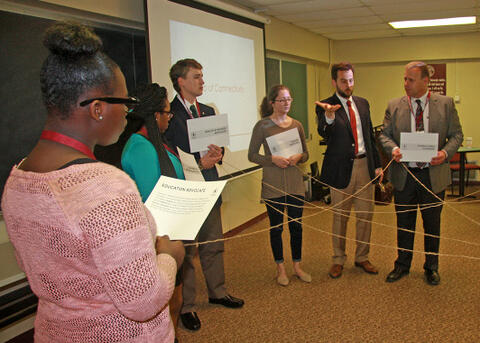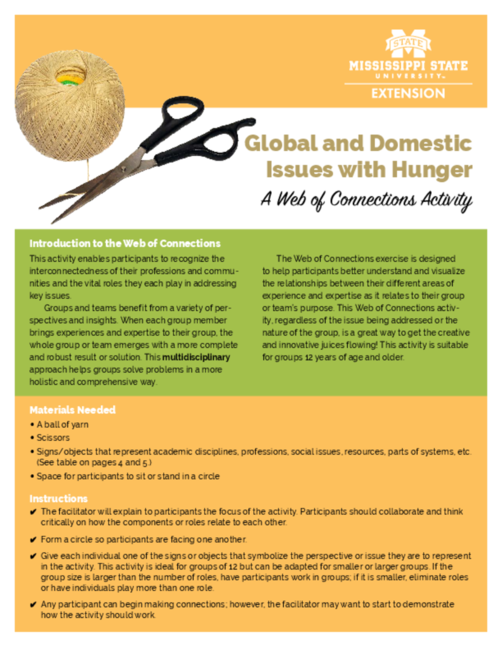P3136
Global and Domestic Issues with Hunger: A Web of Connections Activity
Introduction to the Web of Connections
This activity enables participants to recognize the interconnectedness of their professions and communities and the vital roles they each play in addressing key issues.
Groups and teams benefit from a variety of perspectives and insights. When each group member brings experiences and expertise to their group, the whole group or team emerges with a more complete and robust result or solution. This multidisciplinary approach helps groups solve problems in a more holistic and comprehensive way.
The Web of Connections exercise is designed to help participants better understand and visualize the relationships between their different areas of experience and expertise as it relates to their group or team’s purpose. This Web of Connections activity, regardless of the issue being addressed or the nature of the group, is a great way to get the creative and innovative juices flowing! This activity is suitable for groups 12 years of age and older.
Materials Needed
- A ball of yarn
- Scissors
- Signs/objects that represent academic disciplines, professions, social issues, resources, parts of systems, etc.
(See table below) - Space for participants to sit or stand in a circle
Instructions
- The facilitator will explain to participants the focus of the activity. Participants should collaborate and think critically on how the components or roles relate to each other.
- Form a circle so participants are facing one another.
- Give each individual one of the signs or objects that symbolize the perspective or issue they are to represent in the activity. This activity is ideal for groups of 12 but can be adapted for smaller or larger groups. If the group size is larger than the number of roles, have participants work in groups; if it is smaller, eliminate roles or have individuals play more than one role.
- Any participant can begin making connections; however, the facilitator may want to start to demonstrate how the activity should work.
- The first person or group will start with the ball of yarn and explain to everyone the details of their
assigned component/role (represented by the sign or object). - While holding onto the string, the first person will pass the ball of yarn to another person or group with
a sign or object. - The next person or group then will explain the details of their topic, as well as how theirs is connected to the group before them. The first connection of the web is now made.
- Continue to pass the ball of yarn until everyone has presented their connection, and then cut the string.
- *Note that participants can mention how their topic relates to several of the previously presented ones. For instance, the fourth component/role can be connected with the third, second, or first.
- Lastly, the audience may take the time to discuss the connection made during the activity. A few
examples of discussion questions include:- What other connections are possible that have not been made?
- What connections were the most obvious?
- What connections surprised you?
- How does this exercise influence your feelings about ______________________________________?
- Which additional roles or issues could be added to the web?
- Do you feel like more can be accomplished when groups/interdisciplinary teams are formed?
Why or why not? - How can the connections represented here today help solve problems? Could they complicate
issues even further? - How can you use what you learned during this activity?
Want to expand this activity and make it a multisession set of experiences?
If time permits, students can apply this activity to another specific topic area they are studying. Students may research components and/or professions within that area, and then lead their own Web of Connections activity. Another way to expand this activity is to host a follow-up discussion panel featuring professionals within the field. These additional activities can help students think more independently and gain a deeper perspective of the topic.
To help you facilitate your own Web of Connections activity, we have provided examples for the following topics:
- Community Organizing (MSU Extension Publication 3093)
- Global and Domestic Issues with Hunger (MSU Extension Publication 3136)
- Interprofessional Aspects of Healthcare (MSU Extension Publication 3137)
Each Web of Connections activity also includes an evaluation form for facilitators to obtain participants’ feedback.
Global and Domestic Issues with Hunger


Advocate |
Focus |
|---|---|
|
Hunger Advocate |
Around the world, one person in seven goes to bed hungry each night. In essence, hunger is the most extreme form of poverty, where individuals or families cannot afford to meet their most basic need for food. Undernourishment negatively affects people’s health, productivity, sense of hope, and overall well-being. We need to address hunger not just by giving food, but also by helping farmers in poor countries grow better crops and helping countries build farm-to-market roads so farmers can supply distant cities. |
|
Health & HIV/AIDS Advocate |
More than 38 million people around the world are infected with HIV/AIDS—25 million in Africa alone. The spreading HIV/AIDS epidemic has quickly become a major obstacle in the fight against hunger and poverty in developing countries. Because the majority of those falling sick with AIDS are young adults who normally harvest crops, food production has dropped dramatically in countries with high HIV/AIDS prevalence rates. Left untreated, AIDS leads to early death for people in their most productive years who are needed to raise crops and families, teach school, and care for the sick. |
|
Clean Water & Sanitation Advocate |
One person in seven has no access to clean water for drinking, cooking, or washing. In addition to spreading disease, this has multiple negative effects—girls growing up in villages without water are far less likely to attend school because they’re too busy spending hours walking to and from the nearest water source. Bad health caused by poor sanitation has a knock-on (secondary or incidental) effect on the family economy and nutrition. Building safe water supplies, improving sanitation through well-constructed latrines, and teaching communities about safe hygiene practices are a few ways to improve the health of many around the globe. |
|
Education Advocate |
Parents in Malawi know just as well as parents in Missouri that education is crucial to their children’s future. But around the world, 104 million children do not go to school because their parents cannot afford fees, books, or uniforms. Providing education for women and girls would have a dramatic impact on the poor in developing countries for the sick. |
|
Orphans & Children Advocate |
Every three seconds a child dies of causes related to extreme poverty, hunger, and disease. Around the world, millions of children have already lost one or both parents to AIDS. Unless more is done, there will be 25 million of these children around the world by 2010. Children are more vulnerable to disease because their bodies are weakened from hunger. |
|
Fair Trade Advocate |
As much as people in poor countries appreciate development assistance, no one wants to rely on a handout—they want to trade their way out of poverty— but international rules make it difficult. Farm and trade policies in the United States and the European Union are creating hardships for family farmers everywhere. Seventy-five percent of poor people in developing countries—some 900 million people—depend on agriculture for their livelihood. A fair-trade system would give people in poor countries the chance to earn their way out of poverty by participating in the world economy. |
|
Anticorruption Advocate |
While corruption is harmful to all governments, losing resources to corrupt leaders is particularly devastating in poor countries where every dollar lost means one more child can’t go to school or one more well can’t be dug to provide clean water. Contrary to popular opinion, a large portion of the United States Agency for International Development is channeled through existing private relief and development agencies, like Catholic World Relief, World Vision, CARE, Mercy Corps, and many others. Education is essential for understanding the reality of global development. |
|
Debt Cancellation Advocate |
Every year, Sub-Saharan Africa, the poorest region of the world, spends $14.5 billion repaying debts to the world’s richest countries and international institutions such as the World Bank and International Monetary Fund. For example, the civil conflict in Burundi resulted in an increase in health problems related to malaria, a decrease in education for children, and emotional trauma from years of civil strife. But the money needed to address these concerns is diverted to pay off international debts. Though we’ve made efforts to relieve the unpayable debts of many nations, poor countries still spend more each year on debt than on healthcare or education. |
|
Extreme Poverty Advocate |
Extreme poverty means living on less than $1 a day, unimaginable to us as Americans. In the developing world, more than 1.2 billion people currently live below the international poverty line. Many people are unable to feed their families because they cannot make a decent wage to buy or produce food. |
|
Women & Girls Advocate |
Throughout the world, women work to provide for themselves and their families. They labor hard, but often their work is valued far less than that of men. In many families, women and girls are the last in line not just for food, but for medical care, as well. Pregnant women, new mothers who breastfeed infants, and children are among the most at risk for malnourishment. |
Adapted From
https://www.wfpusa.org/wp-content/uploads/2016/08/Web-of-Connections.pdf

Web of Connections Evaluation Survey
Workshop: Community Organizing to Develop Healthy Environments
Facilitator: _____________________________________________________________________________
Date: _________________________ County: ________________________________________________
Group participating in the activity: _______________________________________________________
Please indicate your response to each item:
Strongly Disagree (SD) | Disagree (D) | Neutral (N) | Agree (A) | Strongly Agree (SA)
This activity…
a. related to my needs.
b. was understandable.
Participating in this activity was worth my time.
I would recommend this activity to others.
My knowledge increased about how people are connected, in general.
My knowledge increased about how different healthcare fields are connected.
My understanding of how different healthcare fields can work together to improve patient outcomes has increased.
I will tell others what I learned through this activity about the interconnectedness of healthcare.
The most important thing I learned through this activity was:
One specific thing that I plan to use or apply as a result of this activity is:
Publication 3136 (POD-11-17)
By David Buys, PhD, MSPH, CPH, Assistant Extension/Research Professor and State Health Specialist, Food Science, Nutrition, and Health Promotion; Brittney Oliver, PhD, Assistant Professor, Food Science, Nutrition, and Health Promotion; Victorian Tilley, Graduate Assistant, Food Science, Nutrition, and Health Promotion; and Laura Brumbaugh-Robertson, Extension Agent, Tate County.
The Mississippi State University Extension Service is working to ensure all web content is accessible to all users. If you need assistance accessing any of our content, please email the webteam or call 662-325-2262.
